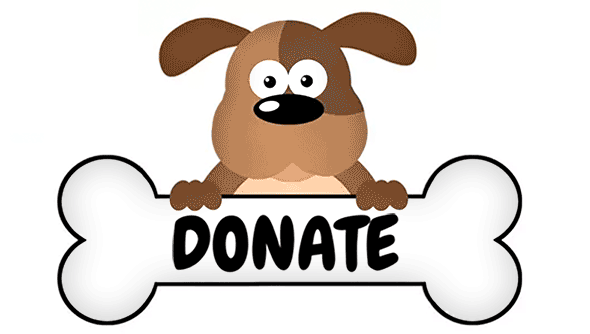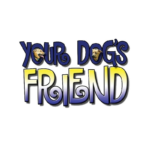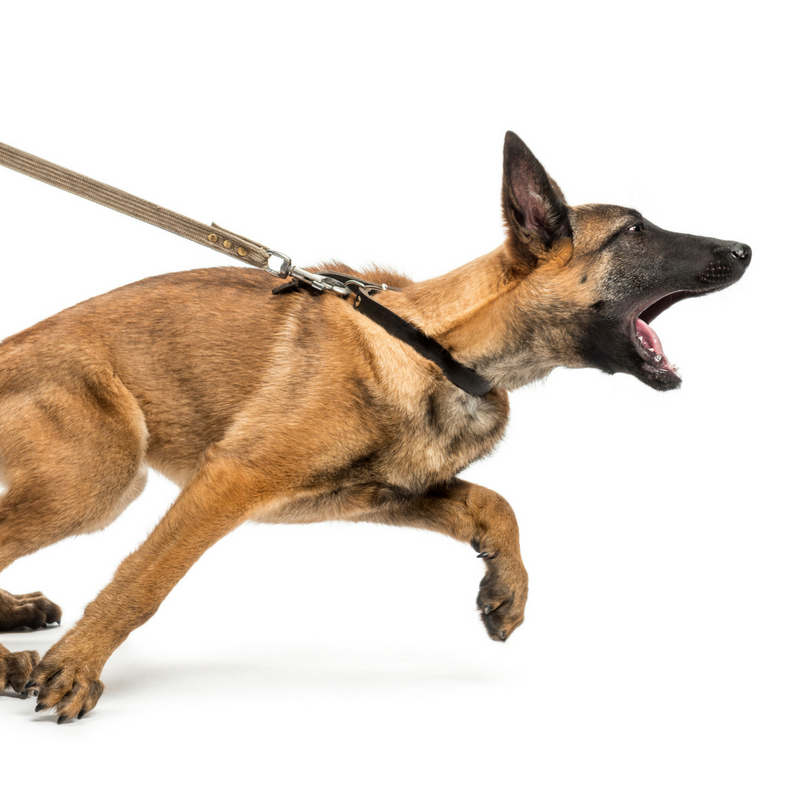
Help! My Dog Barks & Lunges at Other Dogs!
This overview will help you better understand why your dog barks and lunges toward other dogs and what you can do about it. Since it isn’t specific to your dog, consider taking our Reactive Dog Class or working privately with one of the trainers on our referral list.
Reasons for Reactivity
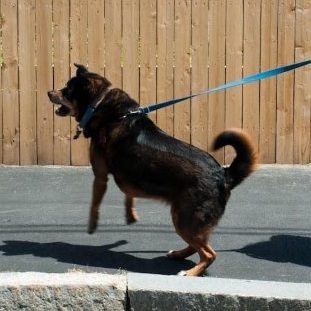
Does this look familiar?
The first thing to recognize is that despite how it looks, nearly all reactivity is rooted in fear. When your dog acts aggressively, he is able to keep other dogs and their people away, and that’s what he wants. Off-leash, a dog could run away. On-leash, a dog is trapped and acts aggressively to protect himself.
The second most frequent reason for reactivity is frustration. Some dogs pull and bark on-leash when they want to get to another dog to play. You will often see dogs frustrated behind a fence as well, when a dog can’t get to what’s on the other side. However, we tend to assign this reason to our dogs more often than we should. We prefer seeing our dog as wanting to play, instead of acting from fear.
Management
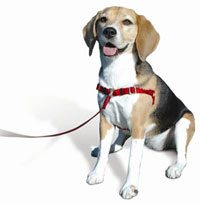
We sell TTouch harnesses at our training center.
The easiest and most immediate help is to use management techniques. When you see another dog, even if your dog hasn’t noticed, turn and go the other way, cross the street, or move behind a car. You get the idea. Don’t wait until your dog starts reacting. You are trying to avoid the problem and prevent your dog from practicing the reactive behavior. The more your dog is able to bark and lunge, the more likely that he’ll do it next time. After all, it does keep other dogs away.
A dog that walks directly toward another dog is considered rude, or even a threat, in the doggy world. However, we put our dogs in this position all the time by walking on sidewalks. Paths are just as narrow, and dogs (more often loose on paths) come right at your dog without room for you to get away. Try to find somewhere less crowded and more open – like outside an office complex or at a park. This will help both you and your dog feel less anxious and enjoy your walk more. Have fun on your walk, so that your dog is engaged with you, instead of what’s happening out there. More on this later.
It’s important that you act calm. If you’re anxious, the emotion transfers down the leash to your dog. Despite your instincts, don’t hold your dog’s leash too short. And please don’t pull back on the leash; if you do, your dog will naturally pull forward. It helps to have a leash that won’t slip through your hands (a leather leash, for example, instead of a nylon one) with knots tied every few feet; holding the leash stable against your body, instead of letting your arm flail around; and a harness, with a front clip, to give you better control if your dog starts lunging. What you don’t want to do, and this is a common response, is to make your dog sit and stay while the other dog is approaching. When you do that, your dog feels trapped, with no ability to get away.
Your Dog’s Emotional Response
To change your dog’s response to other dogs, start working with your dog, standing still, at a distance where he can see another dog without reacting and where other dogs aren’t walking toward you. You can try this exercise, for example, at the edge of a lot where dogs get out to go to a dog park or pet store. Give your dog extra-special treats the moment he sees the other dog and stop the treats when either the other dog leaves or you and your dog walk away. This exercise will help change your dog’s association with other dogs from “that’s scary; I want it to go away” to “dogs make good things happen.” In cases of frustration, this exercise will help your dog too. After a while, your dog will see another dog and look at you, as if to say, “Where’s my treat?”
If your dog starts to bark and lunge, you are too close and need to move back. When your dog is reacting, he isn’t thinking. Don’t expect him to listen to you. When your dog becomes comfortable at a given distance, you can try getting five feet closer. If you move too close too fast, you may see backsliding. Be patient. Since you will be using a lot of treats during this process, break the treats into tiny pea-size pieces. The rate at which you give your dog treats, not the size of the treat, is what matters. Feed your dog one tiny piece after another and remember to reduce what you give him for meals.
Arousal!
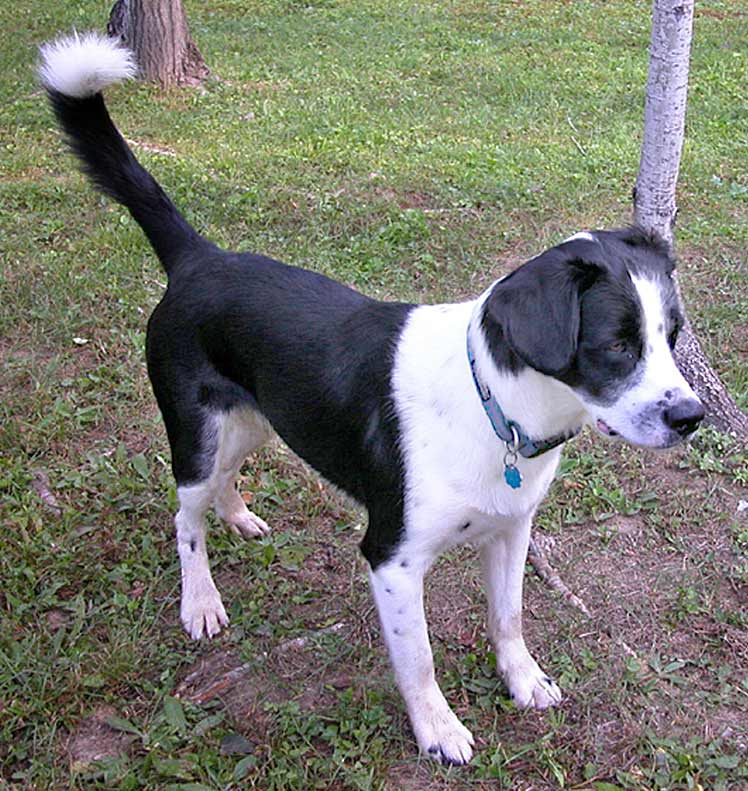
What an overly aroused dog looks like – note the stiff body posture
Many people take their reactive dogs to dog parks or large daycare centers and believe that their dog loves to play and has no problems in these off-leash settings. However, when dogs become overly aroused, chemicals (adrenaline and cortisol) are released into their bloodstream. Those chemicals were once needed for survival, but now only serve to amp up our dogs. Dogs can go from arousal to aggression in an instant. Plus, the chemicals released stay in a dog’s system for a day or more, making aggression more likely.
At dog parks and larger daycares, dogs with different personalities and play styles (chasing, wrestling, body slamming, biting) interact, and may not be compatible playmates. The dogs are often highly aroused, and conflicts can occur. Since there is rarely downtime for dogs to decompress in these situations, it’s not surprising that fights happen. It is not uncommon for dogs that go to dog parks or large daycares to become more reactive elsewhere. The more often a dog is in a state of arousal, the less tolerance he has for the normal stresses of everyday life. Our dog park handout suggests alternatives that will both exercise your dog and provide mental stimulation.
This arousal and subsequent release of adrenaline and cortisol is repeated at other times – for example, when your dog barks at the mail carrier or runs the fence with your neighbor’s dog. Remember that dogs bark because it works. You know that the mail carrier was going to move on anyway, but from your dog’s point of view, the person left because he made a ruckus. And your dog’s “fence fighting”? Your dog thinks that his running and barking at the fence kept your neighbor’s dog on his own property. Plus, it’s fun.
Try to prevent situations that increase your dog’s arousal level. For dogs that bark at everything that moves outside the house, you can buy Decorative Arts window film at Home Depot or Lowe’s that lets you, but not your dog, see out. If you know that there are certain times that your dog is aroused – when the mail carrier comes, when the bus drops off kids after school, when your neighbor’s dog goes for his daily walk – give your dog an interactive or chew toy to occupy him and put on music or a white noise machine.
Stressors
A dog’s behavior deteriorates under stress. So, if your dog reacts more on one day than another, it could be because he had to put up with more that day. Let’s say that your dog barks at other dogs walking by the house all morning, and there’s construction next door, your kids are louder than usual and one of their friends reaches over to pet him. Any or all of that can push your dog over the edge. So, be aware of what stresses your dog and try to help him. For example, if you walk past a dog that always seem to be outside barking, change your route.
Remember that your dog is not being reactive to show dominance or to spite you. He doesn’t like being fearful and stressed any more than you like the resulting “bad” behavior. Your dog’s reactivity and overall well-being can improve, but it can’t happen without your help.
Walking Your Reactive Dog
Here are some ideas to help you and your dog relax more on walks. Be sure to use them frequently, not just when you see another dog. Otherwise, you are signaling that there’s a dog up ahead. The more unpredictable you are, the more your dog will focus on you, instead of scanning ahead for what’s out there.
Avoidance
The easiest thing to do is, of course, to avoid other dogs. Remember – Don’t wait for your dog to react. Go in another direction as soon as you see a dog ahead.
Instead of Panicking
You need a new cue on walks for “something is about to happen and it’s going to be good.” Too often, we train our dogs that something bad is going to happen when we see another dog on our walks. We panic, raise our voice, tighten or yank back on the leash. You need to retrain yourself as well as your dog. At home, practice your phrase. Every time you say it, give your dog lots and lots of treats. Your dog will start watching you whenever you say this phrase, and when you use it on walks it will help you turn your dog away from “encroaching danger.”
Be Unpredictable and Fun!
When on walks, change your pace and direction. Go slowly, speed up, rotate once, then again. Weave around trees, stop for your dog to put his “feet up” on curbs, jump on the bench, then off again. If your dog doesn’t know what his crazy person will do next, his attention will be on you, instead of “out there. “Who cares about those other dogs anyway? My human is way more fun!”
Find It
Play the “Find It” game at home and take it on the road, literally. There’s a dog ahead and you’re stuck with nowhere to go? Toss treats in the grass for your dog to find. This will occupy your dog AND keep his head down, so he is less likely to notice what else is going on while also signaling other dogs that he’s not a threat.
“Run Away”
Practice saying “run away” in a happy voice and running with your dog in another direction. If you get stuck, your dog will recognize this cue as a fun game that will, incidentally, get him away from the dog ahead. If your dog doesn’t follow you in the beginning, throw treats in that direction.
Turn & Go
There are times when you need to “get out of Dodge.” When you are walking and suddenly encounter something that is way too stimulating for your dog, turn in the opposite direction and your dog needs to go with you… quickly. Walk your hands up your leash (without pulling) toward your dog. When you get to your dog’s shoulder, turn into your dog with your legs and hip to help turn him around. If your dog is on your right, you turn into him on your right. If your dog is on your left, you turn into him on your left. Talk the entire time you are turning him around. It helps to bend your knees (with a small dog, it’s crucial).
Back-Up Recall
Dogs need a reason to come to you! You can get your dog’s attention by using your phrase, saying your dog’s name, or making an unusual noise. When your dog looks back at you, run backwards while still facing your dog. This looks like a fun game to your dog, but you’re able to watch your dog and see what’s happening up ahead. You’ll know when it’s safe to continue your walk. If you have taught your dog to target (“touch”), this is a perfect time to play a quick targeting game.
Banana Curves
There are times when you can’t turn around, but there is room to maneuver. Spare your dog the indignity of being challenged. Learn to walk on an arc away from the other dog, as though you are walking in the shape of a banana.
A Blueprint to Help Your Dog
Use the points below as a blueprint for how you can work with your on-leash reactive dog:
- Change your dog’s emotional response to other dogs
- Management techniques
- to prevent your dog from practicing the behavior
- to remove your dog quickly and easily from something unexpected
- Distraction and fun on walks to help your dog focus less on the outside world
- Human confidence: You learn and practice what to do and are less anxious with your dog in public
- Reduce your dog’s overall arousal level
- Equipment that can help keep your dog from pulling (without using choke, prong, or electronic collars), like harnesses with a front clip and double clip leashes
It’s not easy living with a reactive dog. It may even be embarrassing. But you clearly love your dog and want the best for him. Remember that your dog doesn’t like this behavior either. He is trying the best way he knows how to cope. So, whatever your dog has been through in the past, your dog is lucky to have you now. After all, you are looking for help.
Resources
- “Help! My Dog is Reactive” with veterinary behaviorist, Dr. Leslie Sinn. Video on YouTube
- “Walking Your Reactive Dog” with Online Reactive Dog Class instructors, Sarah Stoycos and Marnie Montgomery. Video on YouTube
- Feisty Fido: Help for the Leash-Reactive Dog, Patricia McConnell & Karen London
- Aggression in Dogs: Practical Management, Prevention, and Behavior Modification, Brenda Aloff
- Beware of the Dog: Positive Solutions for Aggressive Behavior in Dogs, Pat Miller
- The Midnight Dog Walkers: Positive Training and Practical Advice for Living with Reactive and Aggressive Dogs by Annie Phenix
- www.careforreactivedogs.com – a free online plan for helping reactive dogs
- www.sniffspot.com – private yards or spaces you can book for your reactive dog to play
Still Need Help?
Contact Your Dog’s Friend at [email protected] or (301)983-5913 for advice and referrals or check out our list of recommended trainers and behaviorists.
Your Dog’s Friend is a nonprofit 501(c)(3) organization working to improve dogs’ lives, reduce problem behaviors, and keep dogs out of shelters, by educating and supporting their humans.
This material is not intended to be a substitute for professional help when dealing with dogs with intense or potentially dangerous behavior issues. Consult a positive reinforcement trainer or veterinary behaviorist for professional assessment, guidance, and support.
